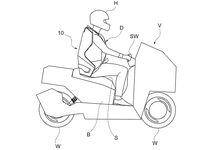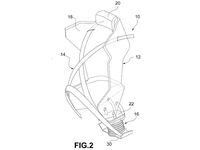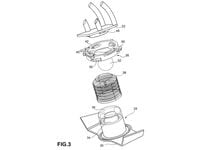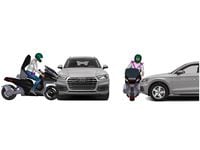It’s hard to argue with the sense of wearing a seatbelt in a car. In an accident you’re less likely to hit squishy human bits against hard machinery if you’re strapped into place. On motorcycles, the situation is totally different, but Italian design and engineering firm Italdesign reckons modern technology means seatbelts might have a future on two wheels as well as four. Italdesign was founded by legendary designer Giorgetto Giugiaro, who’s been behind a huge number of car designs from the original VW Golf to the Lotus Esprit, not to mention bikes including the ’70s Ducati 860 GT and Suzuki RE5, firearms for Beretta, cameras for Nikon, and even the futuristic Seiko watches used in the movie Aliens. However, his company has engineering, testing, and manufacturing capacities as well as its styling arm, and it’s from the engineering side that the motorcycle seatbelt idea arises.
The idea of being strapped on top of several hundred pounds of metal and plastic might not seem very appealing in the event of a bike crash. Without the safety cell of a car, it often makes more sense to get as far as possible from your bike when everything goes wrong, but Italdesign’s idea is to create a seatbelt system that holds you in place in certain accidents, while allowing you to separate from the bike in others.
The system is based around a rigid, shell-like backrest, rather like an oversized back protector, that you strap into via a belt across each shoulder and another over your waist. However, the backrest isn’t permanently, solidly mounted to the bike; instead, it attaches via a flexible joint, allowing some movement of the rider, and there’s a quick-release system that allows the whole shell to be uncoupled from the bike instantly when necessary.
The idea is that the bike’s onboard computer uses sensors to work out if it’s in an accident, and what sort of accident it is, before deciding whether to release the backrest or to hold it—and the strapped-in rider—in place. Overcook it in a corner and low-side the bike, and the seat back will release so you can separate from the machine. However, if a car pulls across the road so you go into the side of it, the system recognizes that it’s safer to keep you strapped in so you aren’t flung into the car or over the top of it.
The system is clearly aimed at scooters or tourers rather than sportbikes; there isn’t enough movement in the backrest’s connection to the seat to allow you to hang off in corners. However, that isn’t necessarily the drawback it might initially seem to be, as car drivers making the switch to two wheels, buying machines like a scooter to commute on, for instance, may actually be attracted to the idea of seatbelts, even though more experienced riders who are used to conventional bikes would probably find the feeling of being strapped in rather disconcerting.




/cloudfront-us-east-1.images.arcpublishing.com/octane/RMCT2KVQBJHBZMRTSLOVPMOILU.jpg)

/cloudfront-us-east-1.images.arcpublishing.com/octane/K45KB2XHQVA65DX7VN4ZSMT2BI.jpg)
/cloudfront-us-east-1.images.arcpublishing.com/octane/BIVAK2SFIBDJJM25E7I5VU2FJE.jpg)
/cloudfront-us-east-1.images.arcpublishing.com/octane/FNHXQQ56BRD7TO4YIJ453PNG2M.jpg)
/cloudfront-us-east-1.images.arcpublishing.com/octane/OIKJC4JA3ZH7BMKUGWYKBIY5FA.jpg)
/cloudfront-us-east-1.images.arcpublishing.com/octane/MT2SAEWY6FDXFBYSLDE3AEFDTM.jpg)
/cloudfront-us-east-1.images.arcpublishing.com/octane/66UPKPYVURBPRCP5HXSN56MEMM.jpg)
/cloudfront-us-east-1.images.arcpublishing.com/octane/EOREGDSRKFDCRJC6K3EDVHBGCE.jpg)
/cloudfront-us-east-1.images.arcpublishing.com/octane/42RF63Q3LVCMBP3DGTWXFYSMOA.jpg)
/cloudfront-us-east-1.images.arcpublishing.com/octane/XNVY3EVWZFCEVPUGJGAN633LXE.jpg)
/cloudfront-us-east-1.images.arcpublishing.com/octane/2PLTVHXY7FDSPFHKU5CFOC43ZY.jpg)
/cloudfront-us-east-1.images.arcpublishing.com/octane/B6M3WTRLFZGNXBEATNXPVGBBD4.jpg)
/cloudfront-us-east-1.images.arcpublishing.com/octane/4CMH3FI73BEM5D6MFYX42FLDSQ.jpg)
/cloudfront-us-east-1.images.arcpublishing.com/octane/RIHAPYNWU5H3XAOXNOPRWCBTQA.jpg)
/cloudfront-us-east-1.images.arcpublishing.com/octane/HU4NUBCL3VAFZA75VYRCMAUHVM.jpg)
/cloudfront-us-east-1.images.arcpublishing.com/octane/OB43AZK7TRA6XLZL5WRDVW2TDA.jpg)
/cloudfront-us-east-1.images.arcpublishing.com/octane/5G44Y3FXWNFSTEQKCA355PXOPU.jpg)

/cloudfront-us-east-1.images.arcpublishing.com/octane/XRI4GTLCVBA5NESASCBIR5LYQI.jpg)
/cloudfront-us-east-1.images.arcpublishing.com/octane/EF7566PXARGMBAOMLWTECYL3LE.jpg)


